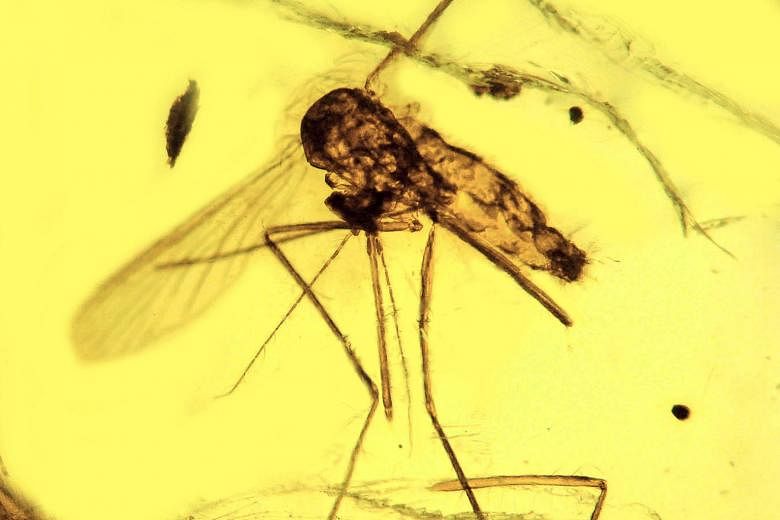Malaria origins traced to age of the dinosaurs
Malaria could have evolved in insects at least 100 million years ago, and their first vertebrate hosts could have included the dinosaurs, a new study has found.
Malaria, a scourge on human society that still kills more than 400,000 people a year, is often thought to be of more modern origins - ranging from 15,000 to eight million years old, caused primarily by one genus of protozoa, Plasmodium, and spread by anopheline mosquitoes.
But the ancestral forms of this disease used different insect vectors and different malarial strains, and may literally have helped shape animal survival and evolution on earth, according to Dr George Poinar Jr, a researcher in the College of Science at Oregon State University.
Dr Poinar suggested in the journal American Entomologist that the origins of this deadly disease may have begun in an insect such as the biting midge more than 100 million years ago.
"Scientists have argued and disagreed for a long time about how malaria evolved and how old it is," Dr Poinar said in a statement by Oregon State University.
"I think the fossil evidence shows that modern malaria vectored by mosquitoes is at least 20 million years old, and earlier forms of the disease, carried by biting midges, are at least 100 million years old and probably much older."
Since the sexual reproduction stage of malaria occurs only in insects, Dr Poinar said in the new study that they must be considered the primary hosts of the disease, and not the vertebrate animals that they infect with disease-causing protozoa.
Understanding the ancient history of malaria evolution might offer clues to how its modern-day life cycle works, how it evolved, and what might make possible targets to interrupt its transmission through its most common vector, the Anopheles mosquito.
2-day-old embroyos show signs of development
Genetic "signatures" of early-stage embryos confirm that development begins to take shape as early as the second day after conception, when they are a mere four cells in size, according to new research led by the University of Cambridge and the European Bioinformatics Institute.
Although they seem to be identical, the cells of the two-day-old embryo are already beginning to display subtle differences.
The researchers used the latest sequencing technologies to model embryo development in mice, looking at the activity of individual genes at a single cell level. They showed that some genes in each of the four cells behaved differently.
The activity of one gene in particular, Sox21, differed the most between cells. The team found that when this gene's activity was reduced, the activity of a master regulator that directs cells to develop into the placenta increased.
"We know that life starts when a sperm fertilises an egg, but we're interested in when the important decisions that determine our future development occur," said Professor Magdalena Zernicka-Goetz from the Department of Physiology, Development and Neuroscience at the University of Cambridge, in a statement by the university.
Craving for salty food linked to gene: Study
Scientists have shed light on why some people crave salty food, even when they know it can be very bad for their health.
Researchers modified mice to remove a gene known to be linked to high blood pressure in humans. The way this is controlled is unclear, said the University of Edinburgh in a statement.
The modified mice craved salt and when they were offered a choice of normal drinking water or saltwater, they drank three times more saltwater than unmodified mice.
The trial also showed that the modified mice had high blood pressure for as long as they drank saltwater.
Their blood pressure became normal again when the saltwater was removed.
The gene could play an important role in controlling both the appetite for salt, and its effect in raising blood pressure, scientists say.
The team will now research whether an affordable drug already used to treat heart disease in some countries can help to bring salt intake under control in patients with heart failure.
Said Dr Matthew Bailey, who led the study: "Our study shows that we have a genetic drive to consume salty food. Understanding how this process works may help us reduce the amount of salt we eat and make it easier for people to follow low-salt diets."
Compiled by Samantha Boh

